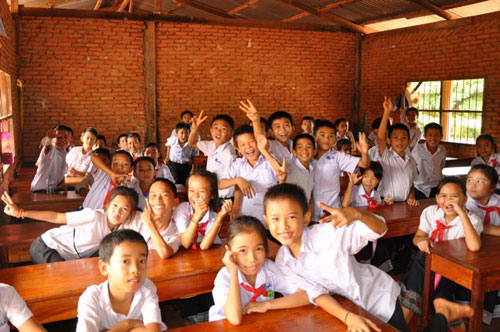Lao Education Quality Lags Despite Investment: World Bank
There are still concerns about the quality of education in Laos, despite greater investment in the sector in recent years, a World Bank report has suggested.
Despite sustained economic growth since the mid 1980s, the Lao education system faces challenges in meeting its goals of providing all students with access to education and improving learning outcomes, the bank said in its 2014 report.
The Lao government has placed a priority on improving its education sector.
But as of 2012 Laos was not on track to achieve its Millennium Development Goal (MDG) of universal primary education.
“There are concerns about education quality as well, particularly whether students are completing primary school with sufficient mathematics and literacy skills,” the bank said.
Recent measures by the government to increase spending on education and thereby improve student outcomes have faced challenges but are beginning to produce modest results, according to the bank.
To formalise its commitment to improving education the Lao government developed the Education Sector Development Framework (ESDF), which documents the education policy objectives in Laos.
It called for increasing public expenditure on education from 11 percent of budget in 2010-11 to around 18 percent by 2015.
The bank cited data from the Ministry of Finance that showed educational expenditure was 13 percent of total government spending in 2011-12.
But non-wage recurrent expenditure in education in the country remains low, according to the ministry’s 2012 data.
Non-wage, public recurrent expenditure is spending that pays for things like school materials, equipment and teacher training.
It currently represents about 20 percent of recurrent expenditure but only between three and seven percent of total education expenditure over the past four years.
As a result, households have had to pay non-mandatory fees for schooling in order to make up for the shortfalls, which could negatively affect access to education for children from poor families.
Low levels of non-wage public spending on education also limit learning resources and quality of facilities in classrooms and schools.
The World Bank said although learning outcomes had improved in recent years only about half of fifth grade students could demonstrate Lao language skills beyond the basic level.
In mathematics learning outcomes are particularly poor and results from 2006 and 2009 suggest a declining trend.
Repetition and dropout rates are high in first grade and to a lesser extent in second grade but improve from then on, according to the bank. The Lao government achieving its MDG on universal primary education would be a great challenge.
Although primary school enrolment reached 96.8 percent last academic year and looks set to achieve the target of 98 percent by 2015, the average primary school completion rate from grades one to five remains far short of the MDG target.
Data from the Ministry of Planning and Investment showed the average completion rate currently stands at only 71.4 percent, far below the 2015 target of 95 percent.
Source: Vientiane Times

